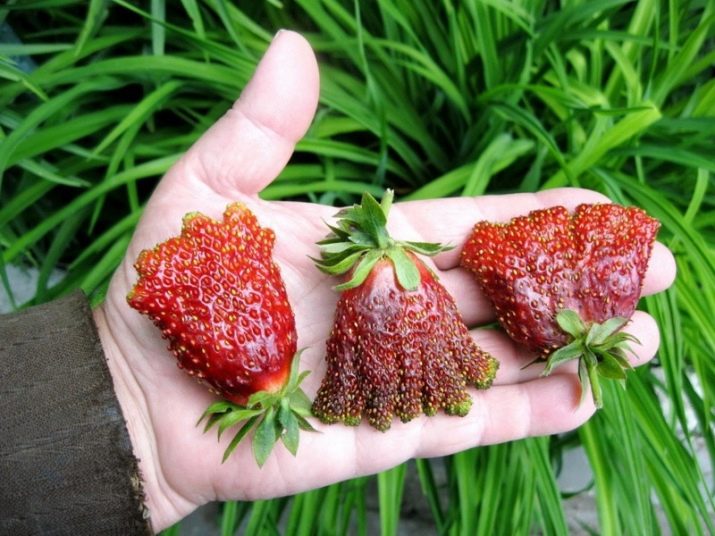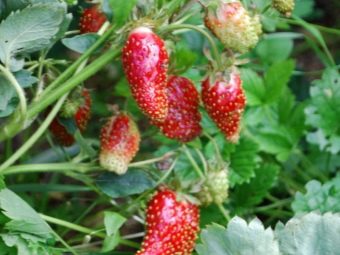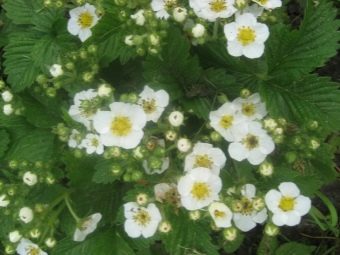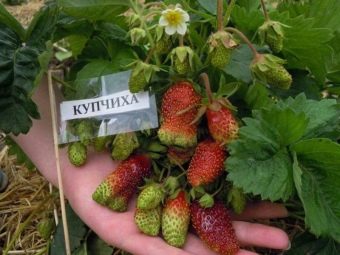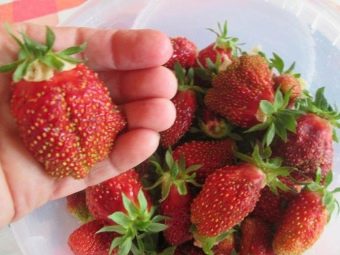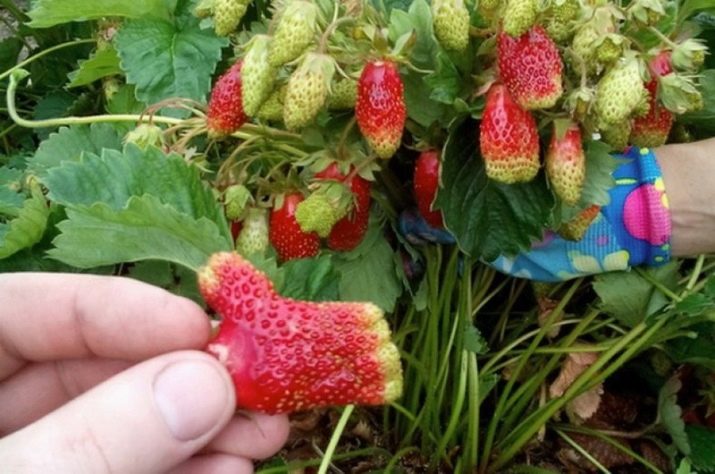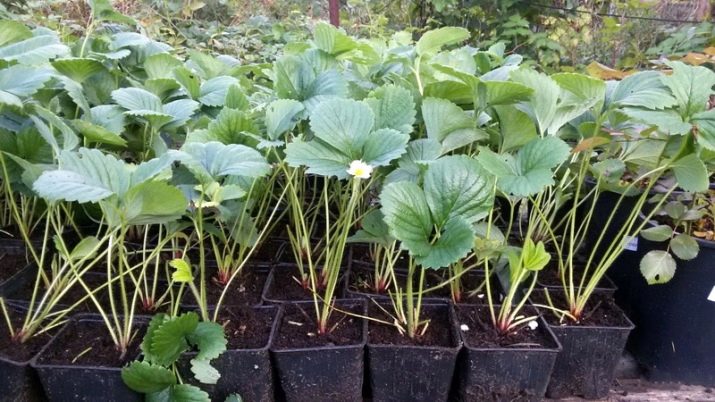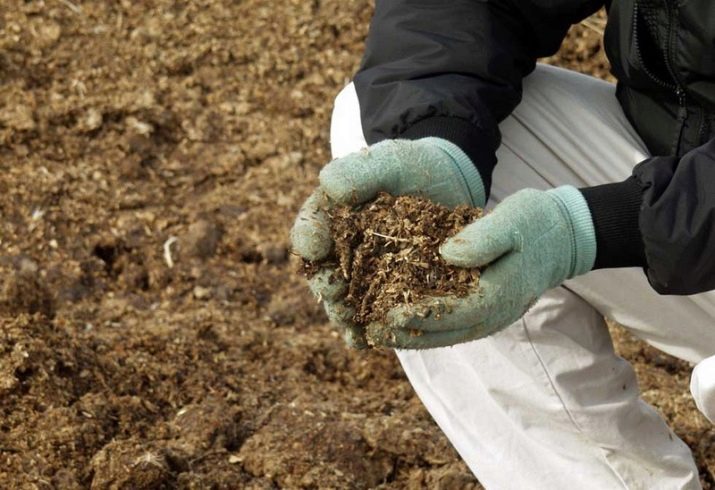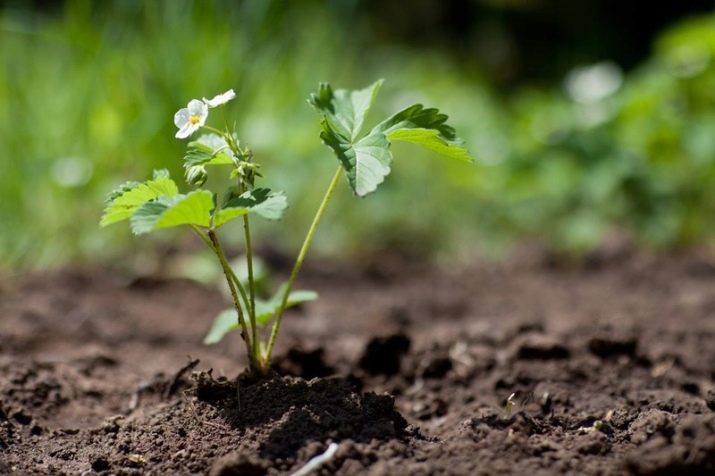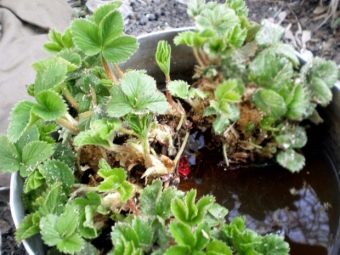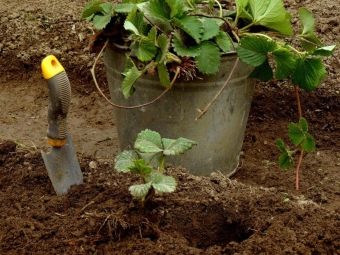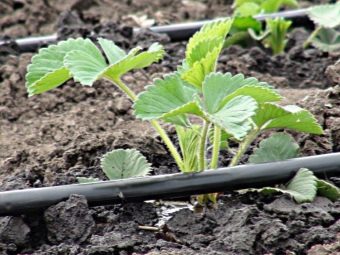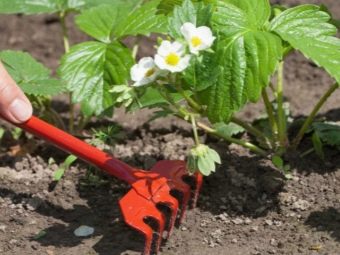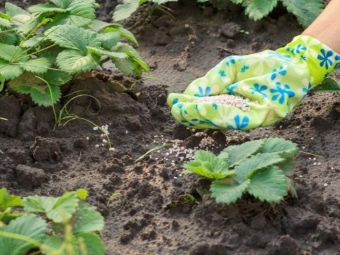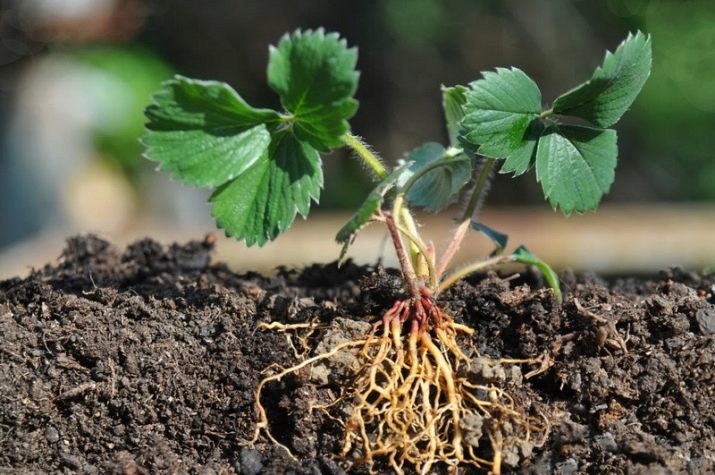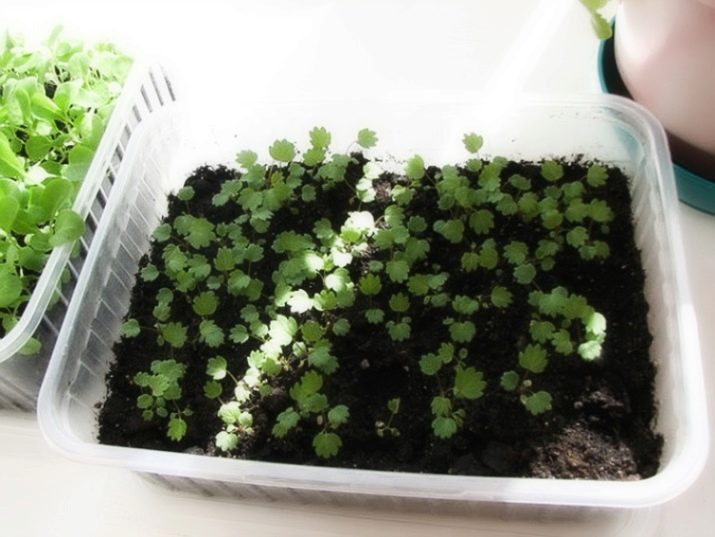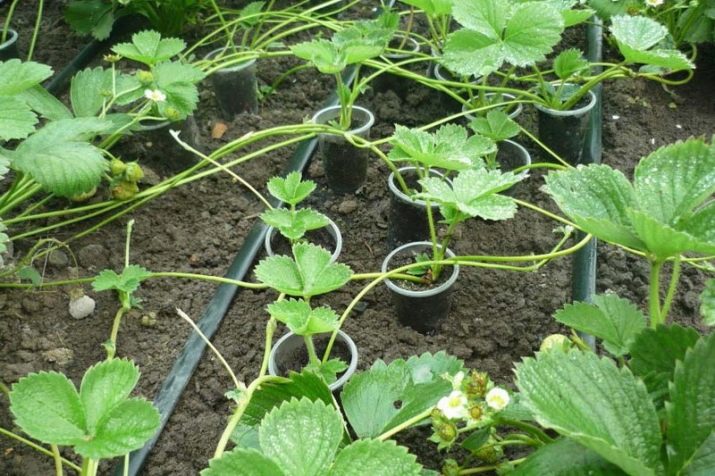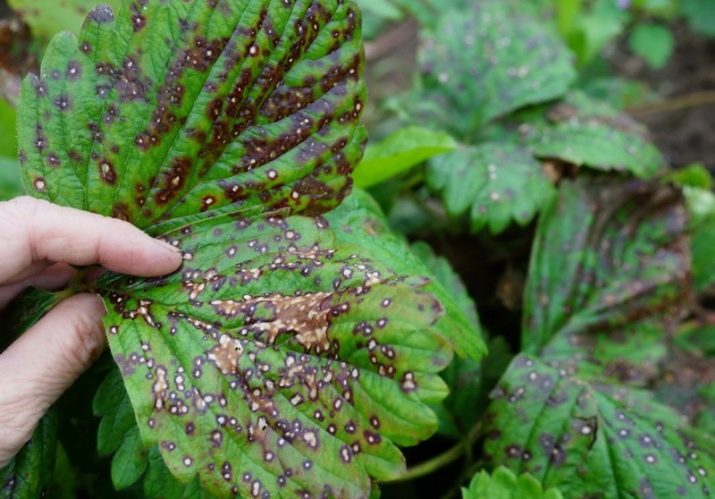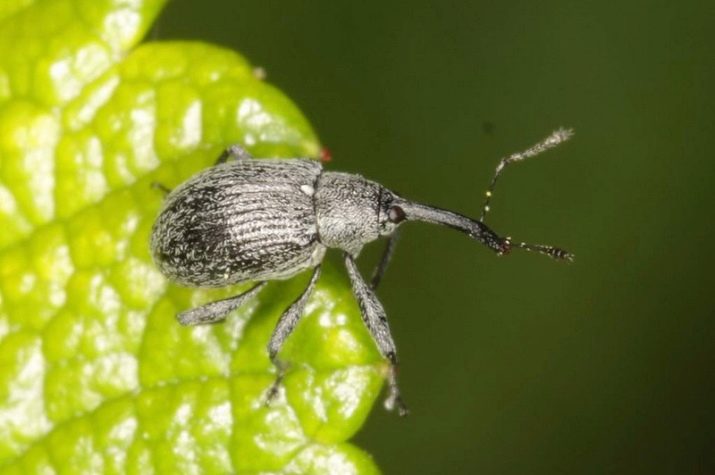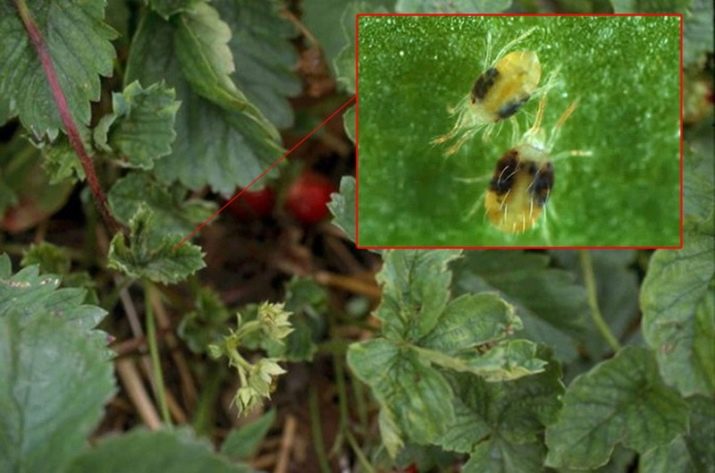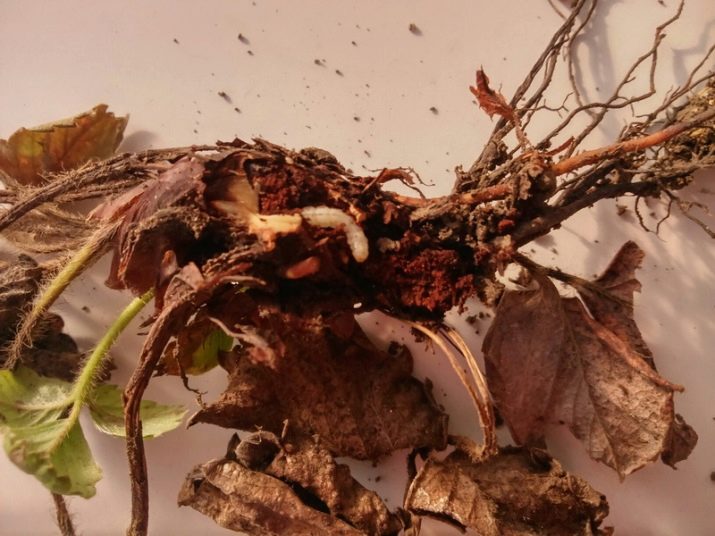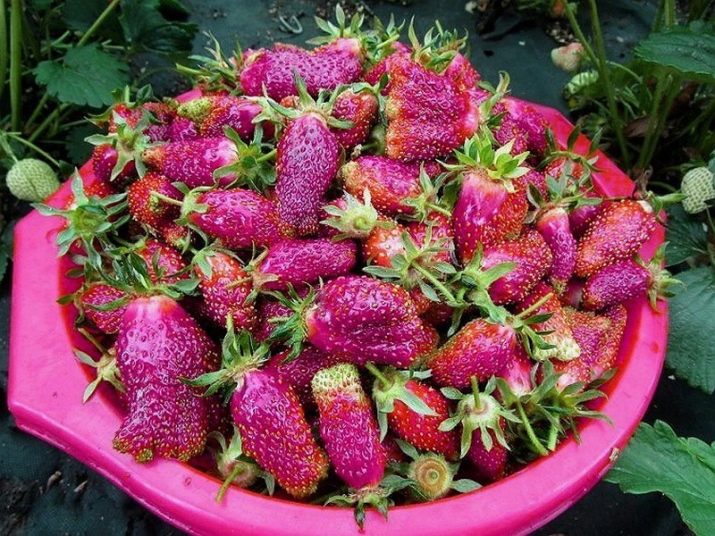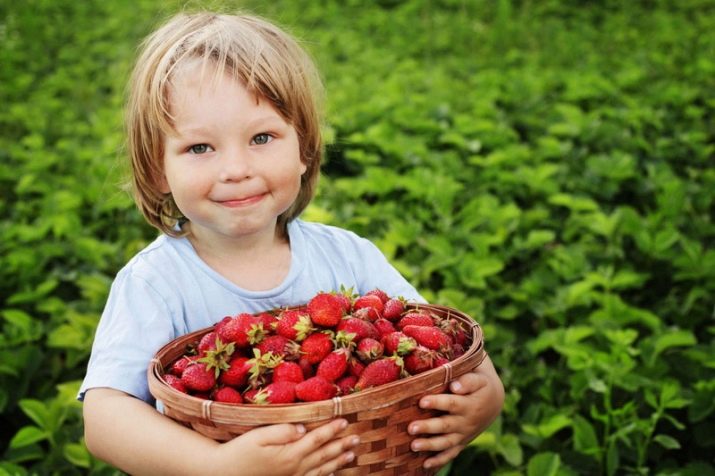Strawberry "Kupchikha": description and cultivation of the variety
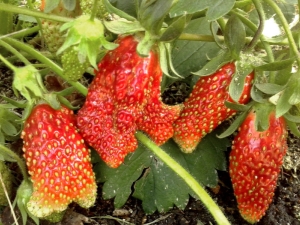
Strawberry is one of the most beloved, popular and grown berries today. A huge variety of its varieties has been developed, the berry is used fresh and is excellent for preservation.Our article is devoted to the variety "Merchant". Let's talk about its characteristics, the intricacies of planting and caring for the plant.
Description and history of breeding
Miracle-berry "Merchant" fell in love with everyone who tried it and this is no accident! Domestic breeders worked since 1970 and not so long ago brought a new improved variety, in which there are practically no cons.
Zemklunika is not a remontant hybrid of European strawberry (nutmeg) and garden strawberries (pineapple)who was fallen in love to gardeners, and also large farmers for the incredibly remembered taste, saturated color, gentle pulp, resistance to low temperatures and bewitching aroma! The advantages of the variety are not only in a special taste, but also in the unpretentiousness of the berry content, which can be safely grown in a variety of climatic conditions. The yield of the variety is about 35 kg / ha.
"Merchant" in its characteristics differs from other varieties of strawberries. During flowering over high (up to 20-30 cm) dense foliage, many white flowers with a yellowish middle open up, forming neat spherical bushes, each of them can be counted up to 30 upright peduncles. Each leaf (dark green) is divided into 3 equal parts, the plate is concave and ribbed, covered with characteristic hairs looking down.
The flowering is plentiful, the variety bears fruit quite well, creating the feeling of a holiday of truly merchant scale. The berries grow large (3-6 cm), ruby-red with a purple tint, oblong, oblate, with a blunt nose, asymmetrical, resemble the shape of bells or paddles. The average weight ranges from 18 to 28 grams (large-fruited berry), from one bush can be collected within 3 kg (in industrial circulation), and on young bushes - up to 700 g.
Berries ripen from mid-June to late July (harvested up to 7 weeks), refers to mid-season, you can grow it in pots or boxes, holding on the balcony, greenhouses and in the fields. The taste is bright, not cloying, but sweet (sugar content up to 5.8%), reminiscent of strawberries, completely sour (0.6% organic acids).
Pros and cons varieties
To the merits of the berries include the following characteristics.
- Beneficial features. Strawberry contains macro and microelements, fruit acids, fiber, vitamins C, E, PP, boosts immunity, improves heart function, strengthens the walls of blood vessels, and has a slight antipyretic effect.
- Stable yields under all kinds of weather conditions, which allows you to grow the plant in almost all regions with temperatures down to minus 24 ° C. The problem of frost is easily solved by covering the beds with coniferous branches.
- Quite large fruits compared to the "relatives" ("White Soul", "Evis Delight").
- Open taste and charming flavor make the berries versatile in use. They are great for preparing various syrups, jam and compotes. Heat treatment does not affect the berry, it still retains its shape and does not lose in the fresh taste.
- Fruits do not fall off, hanging on a thick peduncle, do not rot from over-ripeness and contact with the ground.
- Thanks to the fleshy, dense, low-pulp pulp, transportation and any movement will not harm the strawberries.
- Moderate mustache formation (care becomes more accessible even to amateur beginners).
- High flower ability to pollinate (reaches 90-100%).
- Moisture resistance protects the plant from gray rot, the fruits are practically not affected by powdery mildew and other diseases.
- The decorative look of openwork bushes can be used as an ornament of a garden site.
- Strawberry leaves have healing properties (using an infusion of leaves, you can save yourself from bleeding gums, balance the intestinal microflora and simply enjoy their pleasant aroma and unusual taste).
- Low calorie, allowing you to eat tasty and properly, without harming such a dessert.
"Merchant" - just perfect for summer residents with a rare opportunity to go to the site or poor health, no wonder she was called the healer from all diseases!
The disadvantages include the following features.
- The heterogeneous size of the berries (from small to large), funny shapes of fruits (conical, flattened, with 2-3 horns), but all - elongated. This is a characteristic feature of this variety.
- The number of whiskers is only enough to update the culture, but not for sale. Seed breeding is not recommended, as it is a hybrid plant.
Agricultural Engineering Tips
The agrotechnical cultivation of the “Kupchikh” is simple in execution if you know some subtleties. The first is the choice of good seedlings. The hybrid is still young and there is little information on it, so as not to run into a fraud in the field of gardening, it is better to buy seedlings in proven places. Bushes should have a dense heart of green color, not more than three leaves, healthy appearance (no rot, developed root system). Young hybrid really grow in a pot, greenhouse or open field, depending on the capabilities of the owner.
When planting, it is necessary to calculate that the yield depends on the quality of the planting material and the condition of the soil. It is necessary to remove all weeds, to enrich the earth with oxygen using forks, not shovels. The "poorer" the land, the more fertilizer is required (for each meter - 5 kg of rotted manure, 15 grams of diluted ammonium nitrate, 25 grams of superphosphate and 1 cup of wood ash), so you not only fertilize the soil, but also disinfect it from the fungus. Strawberries are planted in spring (from early May to mid-June) or in autumn (from mid-August to mid-September), these deadlines must be observed, otherwise the berry will die. At the end of the season, urea fertilizer is required (60 g per 20 liters).
The place for growing berries should be well ventilated, and any illumination is allowed: scorching rays or their absence will not affect the taste of the berries, without the sun the fruits will not be less sweet. A huge role is played by the chemical composition of the soil: loamy soils are most suitable for growing, they retain water and contain humus. Sour soil needs to be lime. In clay and sandy soils, you need to add fertilizer in advance, available compost is perfect.
Planting and care
Consider in stages Strawberry planting process.
- Before planting, it is necessary to lower the seedlings with roots into the water for 1.5 hours, irrigating them several times a day.
- Fissures of 7 cm depth are pulled out in the ground
- Planted bushes must be at a distance of 50 cm from each other in a checkerboard pattern. The plant needs space, as the variety grows quickly, and the crowding will prevent the strawberries from full fruit.
- It is recommended to plant seedlings in a pot (provided that the roots have filled the pot completely and the plant is healthy) using the transshipment method, after which the earth is gently rammed without damaging the roots.
- Next, the bush is watered (0.6 l per sapling), after absorbing moisture, the earth loosens and sprinkles with pine needles.
In the care of "Merchant" unpretentious, but despite this, it is necessary to follow some recommendations.
- It is necessary to water the plant in the heat with the drip method, so as not to over-moisten the soil, but do not forget that strawberries grow in well-moistened soil (constantly mulch the soil, spend up to 2 liters of water on one bush).
- Promptly remove weeds and loosen the aisles.
- Do not plant seedlings for more than 6 years in a row on one place, the yield will greatly decrease in the number and size of fruits.
- Moderately fertilize the soil, accompany each procedure with watering.
- Do not neglect the removal of the whiskers, this is a condition of a quality crop (remove on a sunny day, use a sharp shears, do not tear the mustache).
- At the end of the summer and autumn it is not necessary to water, as the rainy season begins.
- Refrain from nitrogen-containing components in fertilizers.
- Before winter, it is enough to cover the beds with raspberry twigs, folded with a dense “cap”.
- During flowering and fruiting, watering is minimized, it is enough that the roots of the plant do not dry out (1 time in 4 days).
- After harvesting is complete, water the bushes every two weeks.
- Pay attention to timely and mandatory inspection of the condition of the bushes in order to prevent the development of diseases in time.
- Do not store seedlings without access to oxygen and soil for more than 10 minutes.
Difficulties with a competent approach to growing usually does not arise, but here are some of them.
- Low yield is possible because strawberry bushes did not reach full ripening period. Do not draw conclusions on the harvest of the first year, a decent amount of berries will be in the third year of cultivation. Do not forget about fertilizing the land (chicken granulated droppings, humus, furnace ash, potash phosphate fertilizers).
- Root rot (weak growth, too deep planting).
Breeding
It can be propagated by seed, but with less success (it is highly likely that strawberries will lose their species, which scientists have tried so hard) than with a mustache (harvest will be only in season, there are a lot of work with seedlings). It is necessary to germinate the seeds, then plant in the soil and wait for seedlings, periodically watering and feeding them. In 1.5 months small sprouts grow (you need to loosen the ground with something small, for example, twigs or matches, a large device will damage the root network). When all the manipulations are completed, the surviving bushes are planted in the ground-fed one-line or two-line way. Experienced gardeners recommend doing this in a single-row method without using non-woven material.
Breeding mustache. After ripening the fruits and their long-awaited collection, choose the strongest and fluffy bushes for breeding, which must be noted so as not to be confused with others. These shrubs are called "uterine", the next year they can not be allowed to ripen berries. It is required to remove absolutely all buds before flowering.
Strawberry breeds with a mustache in stages, first it is grown in pots. After the plant throws out a mustache, transplant the first outlet into a cup, where it should take root. It is possible to remove a mustache connecting a new bush with a plant only when it grows well. After completion of this procedure, strawberries can be transplanted to the beds. The ideal time for transplanting is spring and early summer. Within a month, large rosettes will appear on the bushes, located next to the parent bush, they have a root system with branches, thanks to them strawberries can be multiplied.
Diseases and pests
Berry bushes of the “Kupchikh” are less likely to undergo diseases than their previous counterparts, but still there is a chance to get sick.
Consider the most common problems.
- Fungal diseases. These include brown spotting (brown spots of various shapes) and white spotting (round spots with lilac or red edges), gray rot (fluffy bloom, the berry becomes softer and deteriorates), verticillous wilt. Treatment for prophylaxis or treatment occurs after the snow melt with a bright pink solution of potassium permanganate or Fitosporin (1st. L. For 5 l of water), whey (2 l for 20 l of water), green paint or iodine (1 package for 20 l) .
- Strawberry-raspberry weevil - a beetle with a long trunk. After wintering, females multiply rapidly, crawl into buds and gnaw them, lay their larvae in them, as a result the plant dies. Treatment is needed after flowering with insecticides: Karbofos (30 g per 5 l of water), Aktara (4 g per 20 l), Intavir (2 tablets per 20 l). In the autumn, grieve the earth, destroying the "houses" of beetles.
- Strawberry Mite - invisible to humans, it can be identified by the kind of "Kupchikh". The leaves perish, twist and fall off, become light yellow, frown. Berries almost do not grow, dry and decrease in size. Processing is needed immediately as the snow melts, with hot water up to 80 degrees.In early spring, cover beds with foil without oxygen, so that the tick chokes. The leaves will burn, but do not worry, after a while healthy hearts will grow out of the hearts. For 10 days from the moment of snowfall, spray acaricides: "Aktellik" (1 ml per 1 l of water), "Fufanon" (20 ml per 20 l). In the autumn, you must repeat the procedure for prevention.
- Stem nematode. It deforms the leaves of plants, leads to a dark brown leaf color, the ovary dies, the bushes are stunted, and then cease to grow. Lime tillage will help cope with the scourge.
Gardeners reviews
Basically, the reviews about this variety are positive, buyers note that the “Merchant” can be grown in almost any climatic zone, as the berry successfully adapts to the surrounding regime. Special care is not required, it will be enough to pay attention to rare top dressings of the soil, the works will not be in vain. Berry is available not only for private use, but also for cultivation on an industrial scale. The number of berries damaged by diseases or pests is extremely small: the variety in this regard is truly unique!
The cost of planting material is available to all. If you propagate strawberries with seeds, it is better to buy them from trusted vendors, and trust the choice of seedlings to the local nursery. This hybrid belongs to the first grade, it is balanced, with a bright taste and a great strawberry flavor. This berry just will not leave anyone indifferent.
Basic knowledge and compliance with all the rules and recommendations described in this article will help to grow such a strawberry variety as “Merchant Girl” on your site without any problems. The favorite berry will please not only adults, but also small children (fruits of unusual shape will develop the imagination and saturate the children's body with all the vitamins). Be sure to taste the "Merchant" and try to grow it yourself. After all, it is no secret that the most delicious fruits, berries and vegetables are those that are grown on their own!
Description and cultivation of strawberries varieties "Merchant", see the following video.

